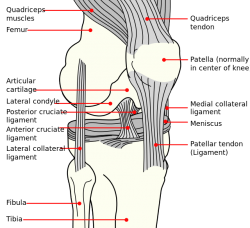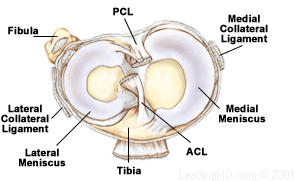Purpose
To test the integrity of the posterior cruciate ligament (PCL)
Technique
The patient is supine and the knee to be tested is flexed to approximately 90 degrees. The examiner then sits on the toes of the tested extremity to help stabilize it. The examiner grasps the proximal lower leg, approximately at the tibial plateau or joint line, and attempts to translate the lower leg posteriorly. The test is considered positive if there is a lack of end feel or excessive posterior translation [1][2]
Evidence
Sensitivity and specificity have been reported as .90 and .99 respectively, while -LR is .10 and +LR is 90.[4] Malanga et al concluded that the posterior drawer test was both very sensitive and specific, but is also enhanced by the presence of a posterior sag sign.[5] Budoff and Nirschl agree that the posterior drawer is the best test to determine PCL integrity, but conclude that grading is the most important as this will determine the course of treatment.[6]
Results from a blinded, randomized, controlled study shows that the accuracy for detection of a PCL-tear is 96%, with 90% sensitivity and a 99% specificity. For grade 2 and grade 3 posterior laxity, the examination accuracy was higher than for grade 1 posterior laxity. [7]
Resources
- ↑ Flynn TW, Cleland JA, Whitman JM. Users’ guide to the musculoskeletal examination: fundamentals for the evidence-based clinician. United States; Evidence in motion: 2008.
- ↑ Magee DJ. Orthopedic Physical Assessment: 5th Edition. St. Louis, MO: Saunders Elsevier; 2008.
- ↑ Clinically Relevant Technologies. Posterior Drawer Test Knee. Available from: ↑ Flynn TW, Cleland JA, Whitman JM. Users’ guide to the musculoskeletal examination: fundamentals for the evidence-based clinician. United States; Evidence in Motion: 2008.
- ↑ Malanga GA, Andrus S, Nadler SF, McLean J. Physical examination of the knee: a review of the original test description and scientific validity of common orthopedic tests. Arch Phys Med Rehabil. 2003;84:592-603.
- ↑ Budoff JE, Nirschl RP. Knee problems: diagnostic tests for ligament injuries. Consultant. 1997;919-930.
- ↑ The Accuracy of the Clinical Examination in the Setting of Posterior Cruciate Ligament Injuries. Rubinstein RA Jr., Shelbourne KD, McCarroll JR, et al: Am J Sports Med 22: 550-557, 1994 (level of evidence: A2)


